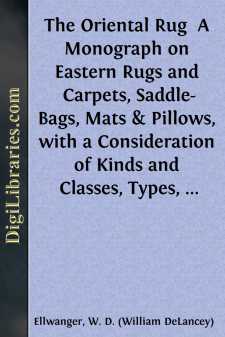Categories
- Antiques & Collectibles 13
- Architecture 36
- Art 48
- Bibles 22
- Biography & Autobiography 813
- Body, Mind & Spirit 142
- Business & Economics 28
- Children's Books 14
- Children's Fiction 11
- Computers 4
- Cooking 94
- Crafts & Hobbies 4
- Drama 346
- Education 46
- Family & Relationships 57
- Fiction 11829
- Games 19
- Gardening 17
- Health & Fitness 34
- History 1377
- House & Home 1
- Humor 147
- Juvenile Fiction 1873
- Juvenile Nonfiction 202
- Language Arts & Disciplines 88
- Law 16
- Literary Collections 686
- Literary Criticism 179
- Mathematics 13
- Medical 41
- Music 40
- Nature 179
- Non-Classifiable 1768
- Performing Arts 7
- Periodicals 1453
- Philosophy 64
- Photography 2
- Poetry 896
- Political Science 203
- Psychology 42
- Reference 154
- Religion 513
- Science 126
- Self-Help 84
- Social Science 81
- Sports & Recreation 34
- Study Aids 3
- Technology & Engineering 59
- Transportation 23
- Travel 463
- True Crime 29
The Oriental Rug A Monograph on Eastern Rugs and Carpets, Saddle-Bags, Mats & Pillows, with a Consideration of Kinds and Classes, Types, Borders, Figures, Dyes, Symbols, etc. Together with Some Practical Advice to Collectors.
Description:
Excerpt
Chapter I
THE MYSTERY OF THE RUG
To judge of an Oriental rug rightly, it must be looked at from several points of view, or, at least, from two aspects; against the light and with the light. From the first standpoint, against the light of knowledge, speaking figuratively, there may be seen only a number of rude and awkward figures in crude colours scattered erratically on a dark or dingy-looking background, a fringe of coarse and ragged strings at either end, and rough frays of yarn at the sides. This is what is accepted by many people as an Oriental rug. And indeed this is what most rugs are.
If, on the other hand, we view our rugs with the light of a better wisdom and happier experience, we will see the richest and softest of colours, the most harmonious shadings and blendings, medallions brilliant as jewels, or geometrical designs beautiful as the rose windows of a cathedral; or, again, graceful combinations of charmingly conventionalized flowers and delicate traceries and arabesques,—all these displaying new glories of ever changing and never tiring beauty. Each woven picture, too, is as soft to tread upon as a closely mown lawn, and caresses the feet that sink into its pile. These are Oriental rugs as their admirers know and love them.
Perhaps the chief charm of all such beautiful rugs is in their mystery. Their designs are odd and strange and full of hidden meanings, and their effects are often evolved from the crudest and clumsiest figures, hooks and squares and angles; they owe their wealth of colour to simple vegetable dyes from the woods and fields and gardens, and yet the secret of many of these dyes is still a secret, or has long ago been lost. The places whence the rugs come, the people who make them and those who sell them, all are mysterious and hard to know and understand.
Moreover, broadly speaking, there are no experts on the subject, no authorities, no literature. He who would know them must learn them by experience. The rug dealers, for the most part, seem to treat their wares merely as so much merchandise, and what knowledge concerning them they are willing to impart is so contradictory as to be almost valueless. Few of them would agree upon the name of an example which might be out of the ordinary, or be able to tell where it was made. Ask of them what a “Mecca” is, and they will stammer in their varying answers. And yet the Armenians who handle most of the rugs in this country are often highly educated, and fully appreciate the beauty of their wares. Their taste, however, is not always our taste, and all the Orientalists seem to retain their barbaric fondness for crude and startling colours. When we would turn to books for information in the matter we find that the authorities are not many. They might be numbered on your fingers and thumbs. These few books, moreover, have been published only in limited editions at high prices, and are not easily obtainable. One of the most important of such works is the sumptuously illustrated, elephantine folio, issued in Vienna in 1892 by the Imperial and Royal Austrian and Commercial Museum....


